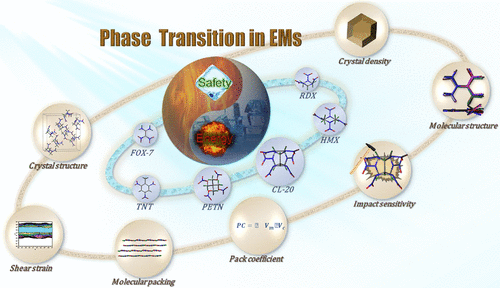当前位置:
X-MOL 学术
›
Cryst. Growth Des.
›
论文详情
Our official English website, www.x-mol.net, welcomes your
feedback! (Note: you will need to create a separate account there.)
Polymorphic Transition in Traditional Energetic Materials: Influencing Factors and Effects on Structure, Property, and Performance
Crystal Growth & Design ( IF 3.2 ) Pub Date : 2020-03-24 , DOI: 10.1021/acs.cgd.0c00233 Rupeng Bu 1 , Hongzhen Li 1 , Chaoyang Zhang 1, 2
Crystal Growth & Design ( IF 3.2 ) Pub Date : 2020-03-24 , DOI: 10.1021/acs.cgd.0c00233 Rupeng Bu 1 , Hongzhen Li 1 , Chaoyang Zhang 1, 2
Affiliation

|
Polymorphism is universal in energetic materials, and polymorphic transformation (PT) causes variations in the structure, properties, and performance. This article reviews the polymorphs of six traditional energetic compounds (ECs), including 2,4,6-trinitrotoluene (TNT), pentaerythritol tetranitrate (PETN), 1,3,5-trinitro-1,3,5-triazinane (RDX), 1,3,5,7-tetranitro-1,3,5,7-tetrazocane (HMX), 2,4,6,8,10,12-hexanitro-2,4,6,8,10,12-hexaazaisowurtzitane (CL-20), and 2,2-dinitroethylene-1,1-diamine (FOX-7), and the PT-induced variations of molecular and packing structures and energies, crystal morphology, sensitivity and detonation performance, and defects, as well as factors influencing the PT and strategies for controlling PT. In all of the polymorphs determined experimentally, there is a small difference in molecular volume, whereas a large difference can appear in molecular conformation, intermolecular distance, packing pattern, crystal density, sensitivity, and detonation performance. Moreover, in addition to temperature and pressure, crystal quality and additive can seriously affect the PT. In addition, recrystallization, coatings, and addition of additives are available to control the PT. Finally, some issues are raised, such as the determination of new polymorphs at high temperature and high pressure, clarifying the PT boundary and mechanism, considering polymorphs at extremes in understanding an EC, and paying attention to the PT of newly thriving energetic cocrystals and energetic ionic salts.
中文翻译:

传统含能材料的多晶型转变:影响因素及其对结构,性能和性能的影响
多态性在高能材料中很普遍,多态性转换(PT)导致结构,特性和性能的变化。本文介绍了六种传统高能化合物(EC)的多晶型物,包括2,4,6-三硝基甲苯(TNT),季戊四醇四硝酸酯(PETN),1,3,5-三硝基-1,3,5-三嗪烷(RDX) ,1,3,5,7-四硝基-1,3,5,7-四唑烷(HMX),2,4,6,8,10,12-hexanitro-2,4,6,8,10,12-六氮杂异纤锌矿型结构烷烃(CL-20)和2,2-二硝基亚乙基-1,1-二胺(FOX-7),以及PT诱导的分子和堆积结构和能量,晶体形态,灵敏度和爆轰性能以及缺陷的变化,以及影响PT的因素和控制PT的策略。通过实验确定的所有多晶型物的分子体积差异很小,而分子构象,分子间距离,堆积模式,晶体密度,灵敏度和爆震性能可能会出现很大差异。此外,除了温度和压力外,晶体质量和添加剂还会严重影响PT。此外,可通过重结晶,涂层和添加添加剂来控制PT。最后,提出了一些问题,例如在高温和高压下确定新的多晶型物,弄清PT的边界和机理,在理解EC时极端考虑了多晶型物,以及关注新发展的高能共晶和高能晶体的PT。离子盐。除温度和压力外,晶体质量和添加剂还会严重影响PT。此外,可通过重结晶,涂层和添加添加剂来控制PT。最后,提出了一些问题,例如在高温和高压下确定新的多晶型物,弄清PT的边界和机理,在理解EC时极端考虑了多晶型物,以及关注新发展的高能共晶和高能晶体的PT。离子盐。除温度和压力外,晶体质量和添加剂还会严重影响PT。此外,可通过重结晶,涂层和添加添加剂来控制PT。最后,提出了一些问题,例如在高温和高压下确定新的多晶型物,弄清PT的边界和机理,在理解EC时极端考虑了多晶型物,以及关注新发展的高能共晶和高能晶体的PT。离子盐。
更新日期:2020-03-24
中文翻译:

传统含能材料的多晶型转变:影响因素及其对结构,性能和性能的影响
多态性在高能材料中很普遍,多态性转换(PT)导致结构,特性和性能的变化。本文介绍了六种传统高能化合物(EC)的多晶型物,包括2,4,6-三硝基甲苯(TNT),季戊四醇四硝酸酯(PETN),1,3,5-三硝基-1,3,5-三嗪烷(RDX) ,1,3,5,7-四硝基-1,3,5,7-四唑烷(HMX),2,4,6,8,10,12-hexanitro-2,4,6,8,10,12-六氮杂异纤锌矿型结构烷烃(CL-20)和2,2-二硝基亚乙基-1,1-二胺(FOX-7),以及PT诱导的分子和堆积结构和能量,晶体形态,灵敏度和爆轰性能以及缺陷的变化,以及影响PT的因素和控制PT的策略。通过实验确定的所有多晶型物的分子体积差异很小,而分子构象,分子间距离,堆积模式,晶体密度,灵敏度和爆震性能可能会出现很大差异。此外,除了温度和压力外,晶体质量和添加剂还会严重影响PT。此外,可通过重结晶,涂层和添加添加剂来控制PT。最后,提出了一些问题,例如在高温和高压下确定新的多晶型物,弄清PT的边界和机理,在理解EC时极端考虑了多晶型物,以及关注新发展的高能共晶和高能晶体的PT。离子盐。除温度和压力外,晶体质量和添加剂还会严重影响PT。此外,可通过重结晶,涂层和添加添加剂来控制PT。最后,提出了一些问题,例如在高温和高压下确定新的多晶型物,弄清PT的边界和机理,在理解EC时极端考虑了多晶型物,以及关注新发展的高能共晶和高能晶体的PT。离子盐。除温度和压力外,晶体质量和添加剂还会严重影响PT。此外,可通过重结晶,涂层和添加添加剂来控制PT。最后,提出了一些问题,例如在高温和高压下确定新的多晶型物,弄清PT的边界和机理,在理解EC时极端考虑了多晶型物,以及关注新发展的高能共晶和高能晶体的PT。离子盐。











































 京公网安备 11010802027423号
京公网安备 11010802027423号